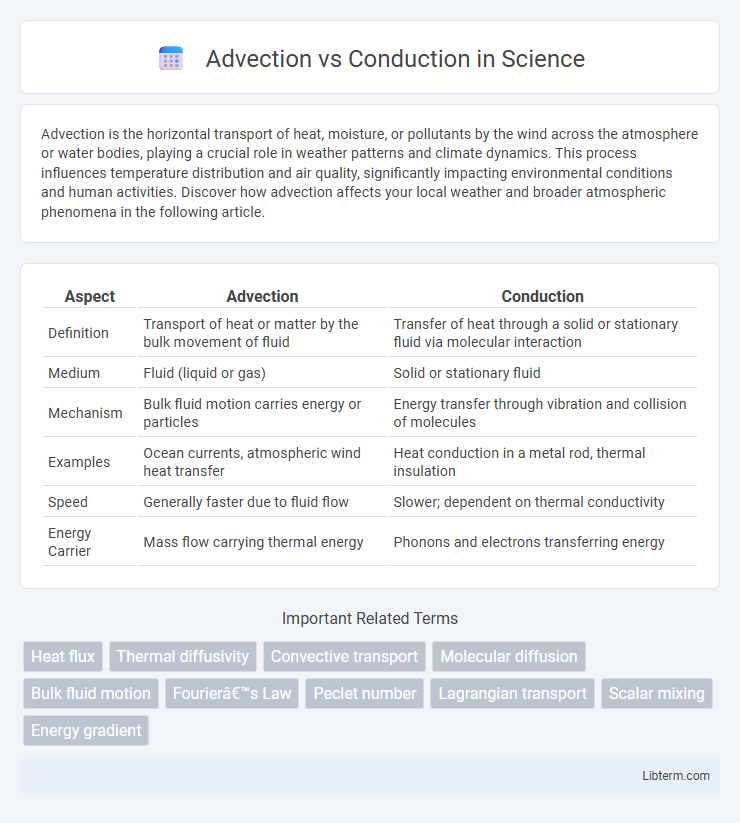Advection is the horizontal transport of heat, moisture, or pollutants by the wind across the atmosphere or water bodies, playing a crucial role in weather patterns and climate dynamics. This process influences temperature distribution and air quality, significantly impacting environmental conditions and human activities. Discover how advection affects your local weather and broader atmospheric phenomena in the following article.
Table of Comparison
| Aspect | Advection | Conduction |
|---|---|---|
| Definition | Transport of heat or matter by the bulk movement of fluid | Transfer of heat through a solid or stationary fluid via molecular interaction |
| Medium | Fluid (liquid or gas) | Solid or stationary fluid |
| Mechanism | Bulk fluid motion carries energy or particles | Energy transfer through vibration and collision of molecules |
| Examples | Ocean currents, atmospheric wind heat transfer | Heat conduction in a metal rod, thermal insulation |
| Speed | Generally faster due to fluid flow | Slower; dependent on thermal conductivity |
| Energy Carrier | Mass flow carrying thermal energy | Phonons and electrons transferring energy |
Introduction to Heat Transfer Mechanisms
Advection and conduction are fundamental heat transfer mechanisms that govern thermal energy movement in different environments. Advection involves the bulk movement of fluid carrying heat by convection currents, typically occurring in liquids and gases. Conduction transfers heat through direct molecular collisions within solids, where thermal energy moves from high to low temperature regions without fluid motion.
What is Advection?
Advection is the process of heat transfer through the bulk movement of fluid, such as air or water, carrying thermal energy from one location to another. It plays a crucial role in atmospheric and oceanic dynamics by moving warm or cold masses horizontally or vertically. Unlike conduction, which involves heat transfer through direct molecular contact, advection relies on the physical transport of the fluid itself.
What is Conduction?
Conduction is the transfer of heat through direct molecular collision within a solid or between solids in contact, without any movement of the material as a whole. It occurs when thermal energy flows from the hotter region to the cooler region due to temperature gradients, governed by Fourier's law of heat conduction. Metals are excellent conductors because of their free electrons, while insulators like wood show low conductivity.
Key Differences Between Advection and Conduction
Advection involves the transport of heat or matter through the movement of a fluid, such as air or water, whereas conduction is the transfer of heat through a solid material without any movement of the material itself. Advection relies on the bulk motion of molecules within fluids for energy transfer, contrasted by conduction's dependence on molecular collisions in stationary materials. The rate of heat transfer in advection significantly depends on the velocity and properties of the fluid, while conduction is governed primarily by the thermal conductivity of the solid medium.
The Role of Molecular Motion in Heat Transfer
Molecular motion plays a crucial role in heat transfer through both advection and conduction processes. In conduction, heat is transferred via the vibration and collision of adjacent molecules within a solid or stationary fluid, relying on microscopic kinetic energy exchange. Advection involves the bulk movement of fluid molecules, carrying thermal energy over larger distances through convection currents or fluid flow.
Real-World Examples of Advection
Advection plays a critical role in weather patterns, where warm air masses move horizontally to influence regional climates, such as the warm Gulf Stream currents affecting the eastern United States. In oceanography, nutrient-rich water advects along coastlines, supporting diverse marine ecosystems and fisheries. Urban heat islands are also impacted by advection, as winds transport heat and pollutants across metropolitan areas, exacerbating temperature extremes and air quality issues.
Real-World Examples of Conduction
Heat conduction is evident in everyday scenarios such as a metal spoon heating in a hot cup of coffee, where thermal energy transfers through the spoon's solid material. Building insulation utilizes conduction principles, as materials like fiberglass slow heat flow to maintain indoor temperatures. Cooking on a stovetop also demonstrates conduction, with heat moving directly from the burner to the pan and then to the food.
Factors Influencing Advection and Conduction
Advection is primarily influenced by fluid velocity, temperature gradients, and the physical properties of the fluid such as density and viscosity, which determine the rate of heat or mass transfer through bulk motion. Conduction depends on the thermal conductivity of the material, temperature difference, cross-sectional area, and the material's thickness, which affect the rate at which heat energy is transferred by molecular collisions. Both processes are governed by their respective transport mechanisms and material characteristics, impacting their efficiency in different environmental and engineering contexts.
Applications in Science and Engineering
Advection and conduction are critical heat transfer mechanisms in science and engineering applications, with advection dominating in fluid flow systems such as atmospheric modeling, oceanography, and HVAC design, where heat and mass are transported by bulk fluid movement. Conduction plays a crucial role in solid materials, impacting thermal management in electronics, building insulation, and materials processing by facilitating direct heat transfer through molecular interactions. Engineers often combine both mechanisms to optimize thermal systems, such as in heat exchangers where conduction transfers heat across surfaces while advection moves heat within fluids.
Summary: Choosing Between Advection and Conduction
Selecting between advection and conduction depends on the heat transfer mechanism and the medium involved. Advection transfers heat through the bulk movement of fluid, making it efficient in gases and liquids where flow occurs, while conduction relies on molecular collisions within solids or stationary fluids. Understanding the dominant physical process and environmental conditions helps optimize thermal management in engineering and natural systems.
Advection Infographic

 libterm.com
libterm.com